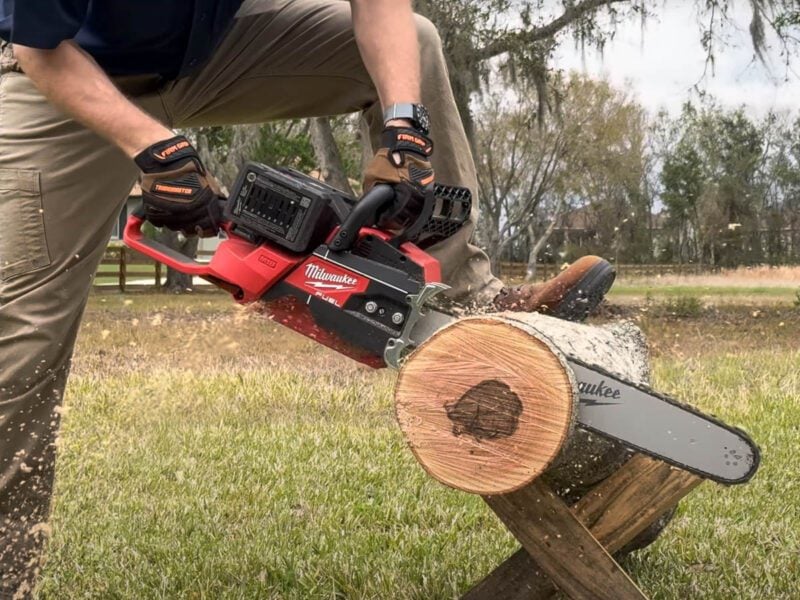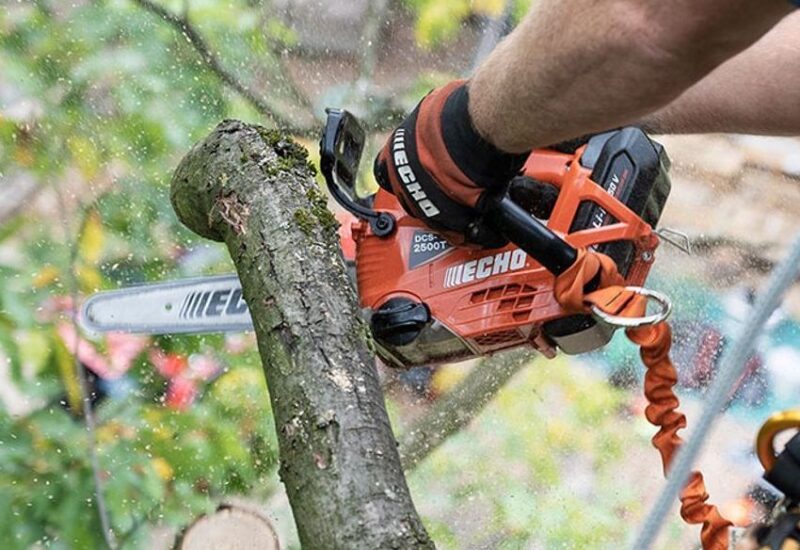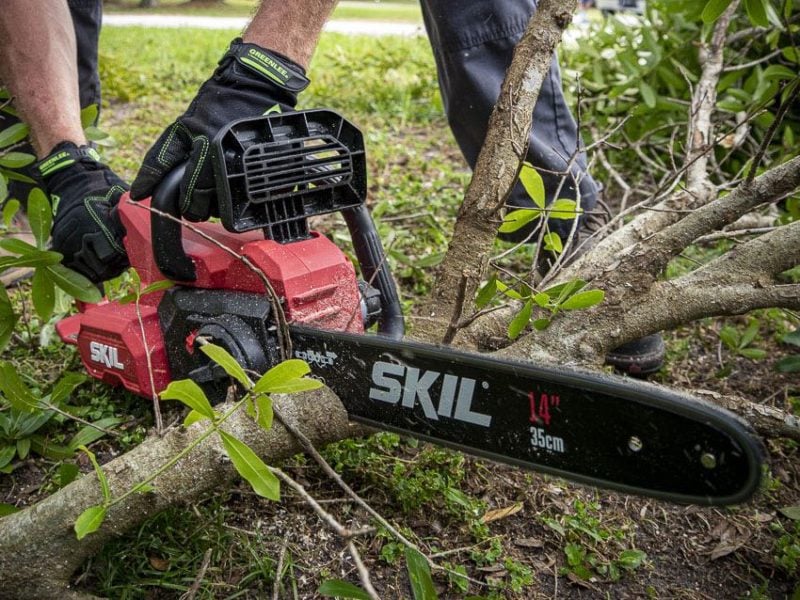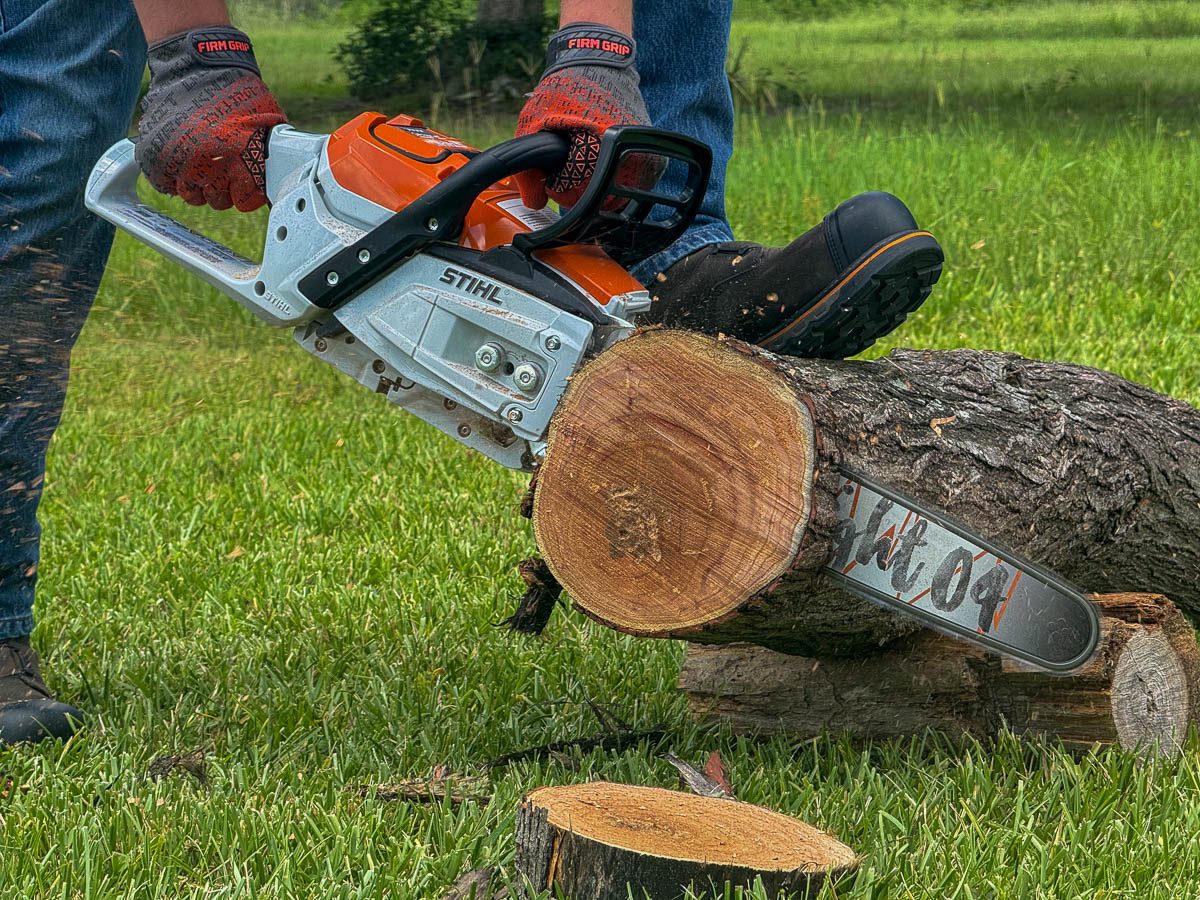Among the many battery vs gas controversies in the outdoor power equipment world, chainsaws are a hot topic. Gas has been the traditional powerhouse, yet marketing teams left and right work hard to convince us that battery is better. I use both types, and I’ll help you take an objective look to determine if battery-powered chainsaws are worth it.
Check out our top recommendations for the best battery-powered chainsaws!
Comparing Gas and Battery-Powered Chainsaws on Paper

The industry has very helpfully adopted gas equivalent power ratings to help us compare battery-powered chainsaws to gas models. It’s no longer a problem to find models that have the power of 40cc, 50cc, or even 60cc gas saws.
Pro-focused models are taking things even further. Milwaukee’s M18 Fuel 20-inch Chainsaw boasts 70cc gas equivalent power, while Greenworks Commercial’s H.O.G. model tops the charts at 80cc.
When it comes to bar length, you have everything from 6-inch pruning chainsaws and 14-inch top-handle chainsaws to 20-inch full-size models. The aforementioned Greenworks Commercial H.O.G. saw can handle a bar up to 28 inches!
Cutting Performance

Specs are one thing, but what about how well they cut?
So far, I haven’t used a battery-powered chainsaw and thought, “Hmm… they seem to be overstating how much power this has.” Those gas equivalent values really do seem to hold up.
However, there are two main differences I notice. The first is the chain selection. Some of the smaller and less powerful battery saws use a 0.043-inch low-profile chain rather than the 0.050-inch chain that’s more common on gas saws.
That smaller gauge has less mass, making it easier for the motor to keep the chain turning, and can cut faster in softwoods, like pine. However, it’s more prone to damage from twisting and wears faster when you’re cutting in hardwoods. Saws that use 0.043-inch chains are usually tuned the motor to keep chain speeds higher at the expense of torque.
Side-by-side, you’ll notice that you can lean into your cut more with a 40cc gas saw using a 0.050-inch chain compared to a 40cc battery saw with a 0.043-inch chain. Both will get the job done, but the gas saw will feel more confident, especially when cutting hardwoods.
We’ve already touched on the other big difference: chain speed. Gas chainsaws tend to have a well-tuned balance of torque and chain speed. They’re fast in softwoods and confident in hardwoods.
Many of the battery-powered chainsaws I’ve used tend to lean one way or the other. Motors geared for higher chain speed usually cut softwood very fast, even faster than gas models in the same cc class. Motors geared for higher torque tend to work relatively slow no matter what species you’re cutting but are more confident in hardwoods.
Gas and Oil vs Batteries

It’s certainly easier to install a battery in your chainsaw than to refill a gas tank, but that’s not the entire conversation.
Charging batteries takes much longer than filling up on gas. While professional brands might get you back to 100% charge in 30 or 45 minutes, that requires an upgraded charger. Standard chargers can take more than an hour and some residential brands might require several hours.
If you only have one or two batteries, it’s easy to outwork them and have to take a break before you can get back to cutting. For non-stop cutting, you’ll need more batteries and a better charger. If you’re not going to be near a power source, you’ll have to load up on batteries. Either way, there’s added expense.
On the other hand, a 5-gallon gas can and a gallon of bar oil can keep a gas saw cutting all day.
Maintenance Concerns

The maintenance marketing claims for battery-powered chainsaws aren’t just hype. Simply filling the bar oil, popping a battery in, and getting to work is incredibly convenient. With no spark plug to foul or carburetor to clog, your chainsaw could have been sitting for six months and fire right up.
When it comes to regular maintenance, you mainly need to make sure you have a sharp chain, replace the bar at the end of its life, and brush off the sawdust when you’re done for the day. All chainsaws will leak oil, so it’s beneficial to empty the reservoir when you’re done, but that’s about it for maintenance.
Price

While entry-level gas saws are often cheaper than their battery-powered counterparts, price tends to even out as you move into the higher performance classes. That’s as a cost to get started, though. From there, how you use your chainsaw makes a difference on how more expensive your choice gets from there.
If you’re a homeowner and have other lawn care tools on the same platform, you might have all the batteries you need for tree maintenance and storm cleanup.
It’s a similar story for landscaping companies making the switch to battery power. If you’re already invested in a battery system, adding more battery-powered tools doesn’t hurt your bottom line that much.
There are a couple of scenarios where you’ll need a bigger investment in extra batteries. If you’re managing a large property, like a farm or ranch, or you’re an arborist switching to full battery for the first time, you’ll need more than just the batteries included in the kit.
While the cost of charging batteries is far less than what you’ll spend on gas, oil, and maintenance on a gas chainsaw, keep in mind that today’s batteries have an expected life span of three to five years. Make sure you add the cost of replacement into your long-term cost calculations.
Should You Buy a Battery-Powered Chainsaw?
I use battery-powered chainsaws more than ones with gas engines. The convenience factor is huge, and it doesn’t take long to adjust your cutting technique to their characteristics. When the conditions call for saws up to 20 inches, battery power is my first choice.
I still turn to gas when I’m cutting large hardwoods or expecting an all-day affair. The higher torque and quick fuel refills are more important than feathering my cuts and managing batteries at that point.
For most homeowners and property owners, battery-powered chainsaws are the way to go. There’s a caveat, though. You need to buy a quality saw on a high-performance battery platform. I would rather go with an entry-level gas saw than an 18V/20V max battery model on most of the DIY systems. They’ll cut, of course, but the performance boost you get from gas at that level trumps the convenience factor.
For Pros, it’s a toss-up. With quality high-performance pruning, top-handle, and rear-handle chainsaws up to 20 inches readily available from several Pro brands, you have everything you need for most jobs. If your business budget can swing the upfront cost of switching, including having enough batteries on hand and charging solutions to get through an entire day, you’ll love the convenience.
That’s a big if, though, even though case studies show that battery power can save you money over the course of each saw’s service life.
Obviously, you’ll still need to use gas for the largest bar lengths. Gas is also easier to access service for repairs, so consider how you’ll deal if something happens.
That said, we’ve reached a point in battery and motor technology that ditching the gas habit is a legitimate option for Pros.



